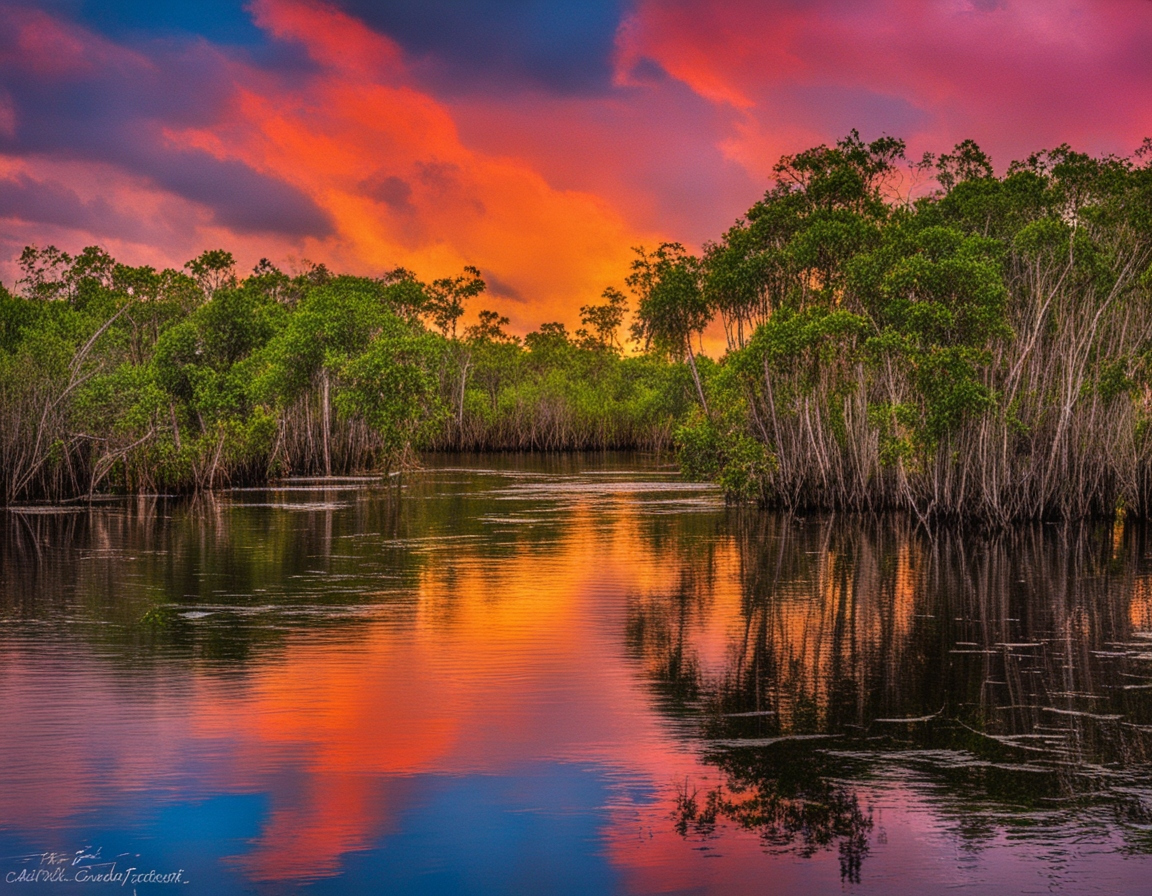Everglades National Park: 7 Unforgettable Wonders of Florida’s Wilderness Wonderland
Introduction
Welcome, fellow nature enthusiasts! Today, we embark on a virtual journey through the enchanting wetlands of Florida, as we dive headfirst into the extraordinary realm of Everglades National Park. Picture this – vast stretches of marshes, mysterious mangroves, and a symphony of wildlife echoing through the air. If you’ve ever yearned for an adventure that immerses you in the heart of untouched wilderness, you’re in for a treat!
Everglades National Park is more than just a destination; it’s a living, breathing ecosystem where every ripple in the water tells a story, and every rustle in the sawgrass conceals a secret. As we navigate the waterways and trails, we’ll unveil the park’s unique wonders – from the iconic alligators basking in the sun to the kaleidoscope of birdlife that graces the skies. Get ready to witness a dance of colors, textures, and sounds that define the untamed beauty of this national treasure.
But our journey doesn’t end with mere observation; it’s an invitation to step into the shoes of the early explorers, the native tribes, and the modern-day adventurers who have been captivated by the allure of the Everglades. Whether you’re planning your own expedition or simply craving a virtual escape, join us as we uncover the magic woven into the very fabric of Everglades National Park – a sanctuary where nature reigns supreme, and every moment promises a discovery. So, buckle up and get ready to navigate the waterways of wonder – the Everglades await!
Attractions in Everglades National Park:
Presented below is a table showcasing the top 25 attractions in Everglades National Park, spotlighting the unique characteristics that set each location apart and make it noteworthy.
| # | Attraction | What’s Special |
|---|---|---|
| 1 | Anhinga Trail | Wildlife viewing, especially alligators and birds. |
| 2 | Shark Valley Observation Tower | Panoramic views of the Everglades, great for birdwatching. |
| 3 | Flamingo Visitor Center | Visitor center with exhibits and information about the park. |
| 4 | Big Cypress National Preserve | Scenic landscapes, cypress trees, and wildlife. |
| 5 | Everglades Airboat Tours | Exciting airboat rides for a unique Everglades experience. |
| 6 | Pa-hay-okee Overlook | Overlook with expansive views of the River of Grass. |
| 7 | Mangrove Wilderness Trails | Kayak or canoe through mangrove tunnels and waterways. |
| 8 | Gumbo Limbo Trail | Short trail with diverse plant and animal life. |
| 9 | Loop Road Scenic Drive | Drive through a scenic loop with opportunities for wildlife sightings. |
| 10 | Nine-Mile Pond Canoe Trail | Canoe trail with a chance to spot alligators and other wildlife. |
| 11 | Pinelands Trail | Trail through pine rocklands, home to unique plant species. |
| 12 | West Lake Canoe Trail | Canoe trail offering a peaceful journey through West Lake. |
| 13 | Christian Point Trail | Hiking trail with scenic views of Florida Bay. |
| 14 | Mrazek Pond | Scenic spot for birdwatching and observing aquatic life. |
| 15 | Paurotis Pond | Wetland area with opportunities to see wading birds. |
| 16 | Roberts Lake Trail | Hiking trail along the lake with diverse flora and fauna. |
| 17 | Rowdy Bend Trail | Trail through a cypress hammock with varied wildlife. |
| 18 | Paurotis Pond Paddle | Paddling adventure in the paurotis palm tree-lined pond. |
| 19 | Long Pine Key Nature Trail | Short trail through a pine forest with birdwatching opportunities. |
| 20 | Coot Bay Pond | Pond with birdwatching and serene water views. |
| 21 | Everglades City | Historic town and gateway to the western portion of the park. |
| 22 | Chokoloskee Island Park | Island park with historical sites and outdoor activities. |
| 23 | Pa-hay-okee Boardwalk | Boardwalk offering expansive views of the sawgrass prairie. |
| 24 | Everglades Alligator Farm | Visit to see and learn about alligators and other wildlife. |
| 25 | Homestead Historic Town | Historic town with preserved buildings and cultural significance. |

General Information:
Everglades National Park:
Everglades National Park, nestled in the southern tip of Florida, is a sprawling wetland ecosystem renowned for its biodiversity. Home to elusive panthers, alligators, and a myriad of bird species, it was established on December 6, 1947.
Location and Size:
Everglades National Park spans over 1.5 million acres, making it the largest tropical wilderness of any kind in the U.S. It extends from the Gulf of Mexico to Florida Bay, playing a crucial role in the state’s ecological balance.
Park History:
The idea for a national park in the Everglades originated in the early 20th century. It took decades of advocacy and conservation efforts before President Truman dedicated the area as a national park in 1947, ensuring its protection for future generations.
Activities and Things to Do:
Park Tours:
Everglades National Park offers a variety of guided tours, allowing visitors to explore its vast landscapes. From ranger-led tram tours to thrilling airboat excursions, there’s an adventure for everyone eager to delve into the heart of this unique ecosystem.
Airboat Tours:
Experience the thrill of gliding over the “River of Grass” on an airboat tour. These high-speed rides provide an up-close encounter with the park’s wildlife, including alligators and exotic birds, making for an exhilarating and educational adventure.
Camping and Hiking:
For the adventurous souls, camping in Everglades National Park offers a chance to immerse in the wild. With designated campsites and hiking trails like the Anhinga Trail and the Flamingo Marina, visitors can get up close with nature.
Wildlife and Animals:
Diverse Animal Life:
Everglades National Park is a haven for wildlife enthusiasts. From the iconic American alligator and the elusive Florida panther to the vibrant Roseate Spoonbill, the park’s diverse habitats support an array of fascinating creatures.
Alligator Encounters:
The iconic alligator is a common sight in Everglades National Park. Visitors can safely observe these ancient reptiles in their natural habitat, providing a thrilling glimpse into the wild side of Florida.
Shark Attacks:
While shark attacks in the Everglades National Park are exceedingly rare, it’s essential for swimmers and water enthusiasts to be cautious, especially in brackish waters where bull sharks, known for their adaptability, may occasionally venture.

Travel and Accommodation:
Hotels Nearby:
Numerous hotels cater to visitors exploring Everglades National Park. From upscale resorts to cozy lodges, options abound for those seeking comfortable accommodation close to the park’s entrances.
Lodging Options:
The Everglades region offers diverse lodging experiences. Whether you prefer the convenience of hotels, the rustic charm of cabins, or the unique allure of houseboat rentals, there’s an option to suit every taste.
Cabin Retreats:
Cabin stays near Everglades National Park provide a perfect blend of comfort and proximity to nature. Imagine waking up to the sounds of wildlife and enjoying evenings under starlit skies after a day of exploration.
Facts and Reviews:
Interesting Facts:
Everglades National Park is not just a swamp; it’s a complex network of ecosystems. Known as the “River of Grass,” the park’s slow-moving water sustains a variety of habitats crucial for countless plant and animal species.
Visitor Reviews:
Visitor reviews often highlight the park’s unique charm and the opportunity to witness wildlife in its natural habitat. From the mesmerizing birdwatching experiences to the educational ranger-led programs, Everglades National Park leaves a lasting impression.
Must-Visit Attractions:
Notable attractions in Everglades National Park include the Anhinga Trail, offering a close encounter with wildlife, and the scenic Shark Valley with its iconic observation tower providing panoramic views of the vast wetlands.
Transportation and Access:
Miami Access:
Miami serves as a gateway to Everglades National Park. Visitors can embark on day trips or guided tours from the vibrant city, making it a convenient starting point for exploring this natural wonder.
Orlando Routes:
Orlando, though located farther north, offers routes to Everglades National Park. Travelers from Orlando can choose to drive or join organized tours to experience the unique ecosystems of the park.
Closest Airport:
The closest airport to Everglades National Park is Miami International Airport (MIA). From there, visitors can easily access the park by car or join guided tours departing from the city.

A Multifaceted Exploration of Nature’s Masterpiece:
Everglades National Park Airboat Tours:
Feel the thrill of the wind in your hair and the splash of water beneath an airboat as you embark on an adrenaline-pumping journey through Everglades National Park. Airboat tours offer a unique perspective, gliding over the park’s expansive wetlands, providing an exhilarating encounter with the wildlife that calls this region home. From the iconic alligators basking in the sun to the vibrant birdlife, this high-speed adventure is a must for those seeking an unforgettable Everglades experience.
Everglades National Park Facts:
Delve into the fascinating facts that make Everglades National Park a truly one-of-a-kind destination. Unravel the mysteries of this UNESCO World Heritage Site, from its intricate water flow systems that sustain diverse ecosystems to its crucial role in preserving endangered species. Discover how the park’s intricate web of habitats contributes to the overall health of the region, making it a living laboratory for researchers and a sanctuary for nature enthusiasts.
Everglades National Park Interesting Facts:
Beyond the ordinary, explore the intriguing and lesser-known tidbits that make Everglades National Park a captivating subject of fascination. Uncover stories of the resilient wildlife adapting to this unique environment, the rare flora that finds a home in the park’s diverse habitats, and the ongoing conservation efforts that aim to protect this ecological treasure for generations to come.
Everglades National Park Wildlife Encounters:
Immerse yourself in the untamed beauty of Everglades National Park through close encounters with its diverse wildlife. From the majestic manatees and elusive Florida panthers to the vibrant array of bird species, each visit promises a wildlife spectacle. Explore the park’s various trails and waterways for the chance to witness these creatures in their natural habitat, creating lasting memories of your connection with the wild.
Everglades National Park Night Sky:
As the sun sets over the vast expanse of Everglades National Park, a celestial display begins. Experience the magic of the night sky, away from city lights, where stars illuminate the darkness, and constellations tell stories of the cosmos. Join stargazing events or simply lay back in the tranquility of the park to witness a celestial panorama that adds a touch of wonder to your Everglades adventure.
Everglades National Park Water Adventures:
Beyond the trails, the waterways of Everglades National Park invite you to embark on a series of aquatic adventures. Kayak through mangrove tunnels, paddle across serene ponds, and navigate labyrinthine water trails. These waterborne journeys offer a unique perspective on the park’s ecosystems, allowing you to witness wildlife from a different angle and embrace the serenity of Everglades waters.
Everglades National Park Birdwatching Bliss:
Calling all bird enthusiasts! Everglades National Park is a haven for avian admirers. With over 360 bird species recorded, including the iconic Roseate Spoonbill and the majestic Bald Eagle, birdwatching becomes a captivating pursuit. Bring your binoculars, follow designated birding trails, and get ready to be enchanted by the vibrant plumage and melodious tunes of Everglades’ feathered residents.
Everglades National Park Cultural Heritage:
Discover the rich cultural tapestry woven into the fabric of Everglades National Park. From the indigenous Miccosukee and Seminole peoples who have called this land home for centuries to the pioneers and conservationists who shaped its modern history, explore the human connection to this remarkable landscape. Engage with exhibits and interpretive programs that highlight the cultural heritage integral to the park’s identity.
Everglades National Park Junior Rangers:
For young explorers, Everglades National Park offers an exciting opportunity to become Junior Rangers. Through interactive programs, educational activities, and hands-on experiences, children can deepen their connection to nature and conservation. Join the ranks of Junior Rangers and embark on a journey of discovery, earning badges and memories that last a lifetime.
Everglades National Park Marsh Walks:
Step onto the boardwalks and trails that wind through the marshes of Everglades National Park for an immersive experience in this unique ecosystem. Marsh walks offer a chance to witness the delicate balance of flora and fauna, from sawgrass to water lilies. Guided tours provide insights into the ecological importance of these wetlands, making each step a lesson in the interconnectedness of life within Everglades National Park.

Fun Facts about Everglades National Park:
Embark on a journey into the heart of Everglades National Park, where nature unveils its marvels in captivating and surprising ways. Here are some fun facts that showcase the uniqueness and intrigue of this iconic natural wonder:
River of Grass:
Everglades National Park is often referred to as the “River of Grass.” Contrary to the image of a traditional river, this vast wetland comprises slow-moving water, creating a unique ecosystem that supports an incredible array of plant and animal life. The “grass” is mainly comprised of sawgrass, which dominates the landscape.
International Biosphere Reserve:
Designated as an International Biosphere Reserve by UNESCO, Everglades National Park is a global treasure. It’s not just a local or national phenomenon; its ecological significance resonates on an international scale. The park’s intricate web of ecosystems, including freshwater sloughs, marl prairies, and hardwood hammocks, contributes to its prestigious status.
Largest Tropical Wilderness:
Everglades National Park holds the distinction of being the largest tropical wilderness of any kind in the U.S. The expanse of over 1.5 million acres showcases the diversity of the tropical and subtropical habitats that make this park a living laboratory for researchers and a haven for wildlife.
Unique Wildlife:
The park is home to an astonishing variety of wildlife, including the iconic American alligator, the elusive Florida panther, and a multitude of bird species. It’s a haven for birdwatchers, with over 360 documented species, making it a birding paradise.
Mangroves and Manatees:
Everglades National Park is one of the few places in the world where you can find both mangrove forests and seagrass beds. These unique environments are vital for the survival of the endangered West Indian manatee, providing crucial habitats for their feeding and breeding.
Preserving Endangered Species:
The park plays a critical role in the conservation of endangered species. Efforts are ongoing to protect and preserve species like the Florida panther, the American crocodile, and the Wood Stork, ensuring that these creatures continue to thrive in their natural habitats.
Miccoxukee and Seminole Heritage:
Everglades National Park is not only a natural marvel but also a repository of cultural heritage. Indigenous peoples, including the Miccoxukee and Seminole tribes, have deep connections to the land, showcasing a harmonious coexistence between nature and culture.
Fire Ecology:
Fire plays a crucial role in shaping the landscapes of the Everglades. Controlled burns are utilized as a conservation tool to maintain the health of ecosystems, stimulate new growth, and reduce the risk of larger, uncontrolled wildfires.
Starry Nights:
With minimal light pollution, Everglades National Park offers breathtaking stargazing opportunities. The night sky becomes a canvas adorned with stars, providing a serene and awe-inspiring experience for those willing to venture into the park after dark.
Junior Ranger Program:
Everglades National Park encourages the next generation of environmental stewards through its Junior Ranger program. Children can actively participate in educational activities, guided walks, and interactive programs, fostering a love for nature and conservation.

Frequently Asked Questions About Shenandoah National Park:
You may also consider discovering information about Grand Teton National Park.

